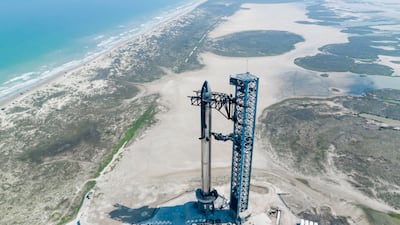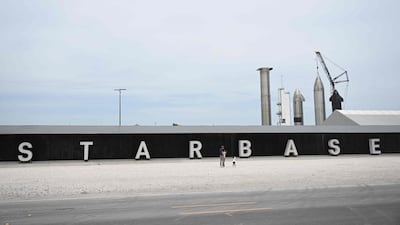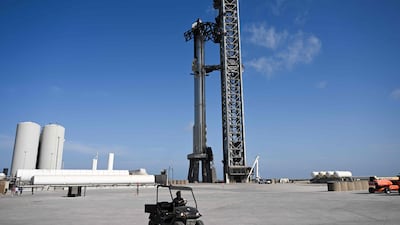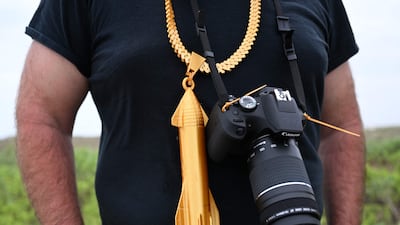SpaceX's Mars rocket Starship could be grounded on the pad for a while longer, as the company was ordered by a US authority on Friday to make necessary corrections before they could receive a launch licence.
The company's owner Elon Musk said last week that the rocket was “ready to launch, awaiting FAA licence approval”, with a new Starship now placed at SpaceX's Starbase pad in Boca Chica, Texas.
This would be the rocket's second test flight, after the first attempt in April failed because of a technical issue.
Engineers had to purposely blow up the rocket mid-flight when the second stage failed to separate from the booster.
Mr Musk had said at the time that the flight still gave them “plenty of data” to try again.
When is the next flight attempt?
The mishap led the US Federal Aviation Administration to launch an investigation into what went wrong.
On Friday, the FAA said that it had closed the investigation after identifying 63 corrective actions SpaceX must take to prevent issues from reoccurring.
This means SpaceX could be waiting a while longer to launch its Starship rocket, as it will have to secure a licence from the FAA first.
“The closure of the mishap investigation does not signal an immediate resumption of Starship launches at Boca Chica,” the FAA said in a statement on Friday.
“SpaceX must implement all corrective actions that impact public safety and apply for and receive a licence modification from the FAA that addresses all safety, environmental and other applicable regulatory requirements prior to the next Starship launch.”
What was SpaceX ordered to correct?
After the first orbital test flight, there were concerns over the large amount of debris that scattered in parts of the town.
The explosion also worried environmentalists, as Boca Chica is surrounded by protected lands that host local wildlife.
Chunks of Starship tumbled back to Earth after engineers ordered a “rapid unplanned disassembly” – a process that automatically disintegrates the rocket.
It had reached a peak altitude of 39 kilometres over the Gulf of Mexico when the mishap took place.
Some of the corrective actions ordered by the FAA include redesigns of vehicle hardware to prevent leaks and fires and a redesign of the launch pad to “increase its robustness”.
Why does Elon Musk want to launch Starship?
Completing an orbital test flight would help SpaceX move closer to its goal of starting commercial operations.
Starship is a two-stage rocket system that includes a booster with the spacecraft on top of it.
SpaceX claims it is the most powerful launch vehicle developed, able to produce 3,991 tonnes of thrust, 15 per cent more than Nasa’s Apollo Moon rocket Saturn V, according to the company's website.
SpaceX has been contracted by Nasa to develop the Starship Human Landing System, which would help astronauts land on the Moon under the US space agency’s Artemis programme.
But Mr Musk's long-term goal is to eventually send humans to Mars using his Starship fleets, helping to “make life multi-planetary”.
He has already sold seats on the rocket, including to Japanese billionaire Yusaku Maezawa, who plans on flying the first crewed flight to the Moon, taking eight artists with him as part of his dearMoon programme.
American billionaire Jared Isaacman is also working with SpaceX through his Polaris programme, a series of privately-led space missions.
Mr Isaacman will serve as commander on the Polaris III mission, the first crewed orbital flight on the Starship rocket.
War 2
Director: Ayan Mukerji
Stars: Hrithik Roshan, NTR, Kiara Advani, Ashutosh Rana
Rating: 2/5
Winners
Ballon d’Or (Men’s)
Ousmane Dembélé (Paris Saint-Germain / France)
Ballon d’Or Féminin (Women’s)
Aitana Bonmatí (Barcelona / Spain)
Kopa Trophy (Best player under 21 – Men’s)
Lamine Yamal (Barcelona / Spain)
Best Young Women’s Player
Vicky López (Barcelona / Spain)
Yashin Trophy (Best Goalkeeper – Men’s)
Gianluigi Donnarumma (Paris Saint-Germain and Manchester City / Italy)
Best Women’s Goalkeeper
Hannah Hampton (England / Aston Villa and Chelsea)
Men’s Coach of the Year
Luis Enrique (Paris Saint-Germain)
Women’s Coach of the Year
Sarina Wiegman (England)
UAE%20v%20West%20Indies
%3Cp%3EFirst%20ODI%20-%20Sunday%2C%20June%204%20%0D%3Cbr%3ESecond%20ODI%20-%20Tuesday%2C%20June%206%20%0D%3Cbr%3EThird%20ODI%20-%20Friday%2C%20June%209%26nbsp%3B%3C%2Fp%3E%0A%3Cp%3EMatches%20at%20Sharjah%20Cricket%20Stadium.%20All%20games%20start%20at%204.30pm%0D%3Cbr%3E%0D%3Cbr%3E%3Cstrong%3EUAE%20squad%3C%2Fstrong%3E%0D%3Cbr%3EMuhammad%20Waseem%20(captain)%2C%20Aayan%20Khan%2C%20Adithya%20Shetty%2C%20Ali%20Naseer%2C%20Ansh%20Tandon%2C%20Aryansh%20Sharma%2C%20Asif%20Khan%2C%20Basil%20Hameed%2C%20Ethan%20D%E2%80%99Souza%2C%20Fahad%20Nawaz%2C%20Jonathan%20Figy%2C%20Junaid%20Siddique%2C%20Karthik%20Meiyappan%2C%20Lovepreet%20Singh%2C%20Matiullah%2C%20Mohammed%20Faraazuddin%2C%20Muhammad%20Jawadullah%2C%20Rameez%20Shahzad%2C%20Rohan%20Mustafa%2C%20Sanchit%20Sharma%2C%20Vriitya%20Aravind%2C%20Zahoor%20Khan%0D%3C%2Fp%3E%0A
Tamkeen's offering
- Option 1: 70% in year 1, 50% in year 2, 30% in year 3
- Option 2: 50% across three years
- Option 3: 30% across five years
Timeline
2012-2015
The company offers payments/bribes to win key contracts in the Middle East
May 2017
The UK SFO officially opens investigation into Petrofac’s use of agents, corruption, and potential bribery to secure contracts
September 2021
Petrofac pleads guilty to seven counts of failing to prevent bribery under the UK Bribery Act
October 2021
Court fines Petrofac £77 million for bribery. Former executive receives a two-year suspended sentence
December 2024
Petrofac enters into comprehensive restructuring to strengthen the financial position of the group
May 2025
The High Court of England and Wales approves the company’s restructuring plan
July 2025
The Court of Appeal issues a judgment challenging parts of the restructuring plan
August 2025
Petrofac issues a business update to execute the restructuring and confirms it will appeal the Court of Appeal decision
October 2025
Petrofac loses a major TenneT offshore wind contract worth €13 billion. Holding company files for administration in the UK. Petrofac delisted from the London Stock Exchange
November 2025
180 Petrofac employees laid off in the UAE
SPEC%20SHEET%3A%20APPLE%20IPHONE%2014%20PRO%20MAX
%3Cp%3E%3Cstrong%3EDisplay%3A%3C%2Fstrong%3E%206.7%22%20Super%20Retina%20XDR%20OLED%2C%202796%20x%201290%2C%20460ppi%2C%20120Hz%2C%202000%20nits%20max%2C%20HDR%2C%20True%20Tone%2C%20P3%2C%20always-on%3C%2Fp%3E%0A%3Cp%3E%3Cstrong%3EProcessor%3A%3C%2Fstrong%3E%20A16%20Bionic%2C%206-core%20CPU%2C%205-core%20GPU%2C%2016-core%20Neural%20Engine%3C%2Fp%3E%0A%3Cp%3E%3Cstrong%3EMemory%3A%3C%2Fstrong%3E%206GB%3C%2Fp%3E%0A%3Cp%3E%3Cstrong%3ECapacity%3A%3C%2Fstrong%3E%20128%2F256%2F512GB%20%2F%201TB%3C%2Fp%3E%0A%3Cp%3E%3Cstrong%3EPlatform%3A%3C%2Fstrong%3E%20iOS%2016%3C%2Fp%3E%0A%3Cp%3E%3Cstrong%3EMain%20camera%3A%3C%2Fstrong%3E%20Triple%2048MP%20main%20(f%2F1.78)%20%2B%2012MP%20ultra-wide%20(f%2F2.2)%20%2B%2012MP%20telephoto%20(f%2F2.8)%2C%206x%20optical%2C%2015x%20digital%2C%20Photonic%20Engine%2C%20Deep%20Fusion%2C%20Smart%20HDR%204%2C%20Portrait%20Lighting%3C%2Fp%3E%0A%3Cp%3E%3Cstrong%3EMain%20camera%20video%3A%3C%2Fstrong%3E%204K%20%40%2024%2F25%2F30%2F60fps%2C%20full-HD%20%40%2025%2F30%2F60fps%2C%20HD%20%40%2030fps%2C%20slo-mo%20%40%20120%2F240fps%2C%20ProRes%20(4K)%20%40%2030fps%3B%20night%2C%20time%20lapse%2C%20cinematic%2C%20action%20modes%3B%20Dolby%20Vision%2C%204K%20HDR%3C%2Fp%3E%0A%3Cp%3E%3Cstrong%3EFront%20camera%3A%3C%2Fstrong%3E%2012MP%20TrueDepth%20(f%2F1.9)%2C%20Photonic%20Engine%2C%20Deep%20Fusion%2C%20Smart%20HDR%204%2C%20Portrait%20Lighting%3B%20Animoji%2C%20Memoji%3C%2Fp%3E%0A%3Cp%3E%3Cstrong%3EFront%20camera%20video%3A%3C%2Fstrong%3E%C2%A04K%20%40%2024%2F25%2F30%2F60fps%2C%20full-HD%20%40%2025%2F30%2F60fps%2C%20slo-mo%20%40%20120%2F240fps%2C%20ProRes%20(4K)%20%40%2030fps%3B%20night%2C%20time%20lapse%2C%20cinematic%2C%20action%20modes%3B%20Dolby%20Vision%2C%204K%20HDR%3C%2Fp%3E%0A%3Cp%3E%3Cstrong%3EBattery%3A%3C%2Fstrong%3E%204323mAh%2C%20up%20to%2029h%20video%2C%2025h%20streaming%20video%2C%2095h%20audio%3B%20fast%20charge%20to%2050%25%20in%2030min%3B%20MagSafe%2C%20Qi%20wireless%20charging%3C%2Fp%3E%0A%3Cp%3E%3Cstrong%3EConnectivity%3A%3C%2Fstrong%3E%20Wi-Fi%2C%20Bluetooth%205.3%2C%20NFC%20(Apple%20Pay)%3C%2Fp%3E%0A%3Cp%3E%3Cstrong%3EBiometrics%3A%3C%2Fstrong%3E%20Face%20ID%3C%2Fp%3E%0A%3Cp%3E%3Cstrong%3EI%2FO%3A%3C%2Fstrong%3E%20Lightning%3C%2Fp%3E%0A%3Cp%3E%3Cstrong%3EDurability%3A%3C%2Fstrong%3E%20IP68%2C%20dust%2Fsplash%2Fwater%20resistant%20up%20to%206m%20up%20to%2030min%3C%2Fp%3E%0A%3Cp%3E%3Cstrong%3ECards%3A%3C%2Fstrong%3E%20Dual%20eSIM%20%2F%20eSIM%20%2B%20eSIM%20(US%20models%20use%20eSIMs%20only)%3C%2Fp%3E%0A%3Cp%3E%3Cstrong%3EColours%3A%3C%2Fstrong%3E%20Deep%20purple%2C%20gold%2C%20silver%2C%20space%20black%3C%2Fp%3E%0A%3Cp%3E%3Cstrong%3EIn%20the%20box%3A%3C%2Fstrong%3E%20iPhone%2014%20Pro%20Max%2C%20USB-C-to-Lightning%20cable%2C%20one%20Apple%20sticker%3C%2Fp%3E%0A%3Cp%3E%3Cstrong%3EPrice%3A%3C%2Fstrong%3E%20Dh4%2C699%20%2F%20Dh5%2C099%20%2F%20Dh5%2C949%20%2F%20Dh6%2C799%3C%2Fp%3E%0A
Tottenham's 10 biggest transfers (according to transfermarkt.com):
1). Moussa Sissokho - Newcastle United - £30 million (Dh143m): Flop
2). Roberto Soldado - Valencia - £25m: Flop
3). Erik Lamela - Roma - £25m: Jury still out
4). Son Heung-min - Bayer Leverkusen - £25m: Success
5). Darren Bent - Charlton Athletic - £21m: Flop
6). Vincent Janssen - AZ Alkmaar - £18m: Flop
7). David Bentley - Blackburn Rovers - £18m: Flop
8). Luka Modric - Dynamo Zagreb - £17m: Success
9). Paulinho - Corinthians - £16m: Flop
10). Mousa Dembele - Fulham - £16m: Success
UAE currency: the story behind the money in your pockets
World record transfers
1. Kylian Mbappe - to Real Madrid in 2017/18 - €180 million (Dh770.4m - if a deal goes through)
2. Paul Pogba - to Manchester United in 2016/17 - €105m
3. Gareth Bale - to Real Madrid in 2013/14 - €101m
4. Cristiano Ronaldo - to Real Madrid in 2009/10 - €94m
5. Gonzalo Higuain - to Juventus in 2016/17 - €90m
6. Neymar - to Barcelona in 2013/14 - €88.2m
7. Romelu Lukaku - to Manchester United in 2017/18 - €84.7m
8. Luis Suarez - to Barcelona in 2014/15 - €81.72m
9. Angel di Maria - to Manchester United in 2014/15 - €75m
10. James Rodriguez - to Real Madrid in 2014/15 - €75m
The specs
Engine: Direct injection 4-cylinder 1.4-litre
Power: 150hp
Torque: 250Nm
Price: From Dh139,000
On sale: Now
Reputation
Taylor Swift
(Big Machine Records)
The specs
- Engine: 3.9-litre twin-turbo V8
- Power: 640hp
- Torque: 760nm
- On sale: 2026
- Price: Not announced yet
Avatar: Fire and Ash
Director: James Cameron
Starring: Sam Worthington, Sigourney Weaver, Zoe Saldana
Rating: 4.5/5
Director: Shady Ali
Cast: Boumi Fouad , Mohamed Tharout and Hisham Ismael
Rating: 3/5
Copa del Rey
Barcelona v Real Madrid
Semi-final, first leg
Wednesday (midnight UAE)
Dubai works towards better air quality by 2021
Dubai is on a mission to record good air quality for 90 per cent of the year – up from 86 per cent annually today – by 2021.
The municipality plans to have seven mobile air-monitoring stations by 2020 to capture more accurate data in hourly and daily trends of pollution.
These will be on the Palm Jumeirah, Al Qusais, Muhaisnah, Rashidiyah, Al Wasl, Al Quoz and Dubai Investment Park.
“It will allow real-time responding for emergency cases,” said Khaldoon Al Daraji, first environment safety officer at the municipality.
“We’re in a good position except for the cases that are out of our hands, such as sandstorms.
“Sandstorms are our main concern because the UAE is just a receiver.
“The hotspots are Iran, Saudi Arabia and southern Iraq, but we’re working hard with the region to reduce the cycle of sandstorm generation.”
Mr Al Daraji said monitoring as it stood covered 47 per cent of Dubai.
There are 12 fixed stations in the emirate, but Dubai also receives information from monitors belonging to other entities.
“There are 25 stations in total,” Mr Al Daraji said.
“We added new technology and equipment used for the first time for the detection of heavy metals.
“A hundred parameters can be detected but we want to expand it to make sure that the data captured can allow a baseline study in some areas to ensure they are well positioned.”
Results
2.30pm: Dubai Creek Tower – Handicap (PA) Dh40,000 (Dirt) 1,200m; Winner: Marmara Xm, Gary Sanchez (jockey), Abdelkhir Adam (trainer)
3pm: Al Yasmeen – Maiden (PA) Dh40,000 (D) 1,700m; Winner: AS Hajez, Jesus Rosales, Khalifa Al Neyadi
3.30pm: Al Ferdous – Maiden (PA) Dh40,000 (D) 1,700m; Winner: Soukainah, Sebastien Martino, Jean-Claude Pecout
4pm: The Crown Prince Of Sharjah – Prestige (PA) Dh200,000 (D) 1,200m; Winner: AF Thayer, Ray Dawson, Ernst Oertel
4.30pm: Sheikh Ahmed bin Rashid Al Maktoum Cup – Handicap (TB) Dh200,000 (D) 2,000m; Winner: George Villiers, Antonio Fresu, Bhupat Seemar
5pm: Palma Spring – Handicap (PA) Dh40,000 (D) 2,000m; Winner: Es Abu Mousa, Antonio Fresu, Abubakar Daud
UAE's role in anti-extremism recognised
General John Allen, President of the Brookings Institution research group, commended the role the UAE has played in the fight against terrorism and violent extremism.
He told a Globsec debate of the UAE’s "hugely outsized" role in the fight against Isis.
"It’s trite these days to say that any country punches above its weight, but in every possible way the Emirates did, both militarily, and very importantly, the UAE was extraordinarily helpful on getting to the issue of violent extremism," he said.
He also noted the impact that Hedayah, among others in the UAE, has played in addressing violent extremism.
As it stands in Pool A
1. Japan - Played 3, Won 3, Points 14
2. Ireland - Played 3, Won 2, Lost 1, Points 11
3. Scotland - Played 2, Won 1, Lost 1, Points 5
Remaining fixtures
Scotland v Russia – Wednesday, 11.15am
Ireland v Samoa – Saturday, 2.45pm
Japan v Scotland – Sunday, 2.45pm
It Was Just an Accident
Director: Jafar Panahi
Stars: Vahid Mobasseri, Mariam Afshari, Ebrahim Azizi, Hadis Pakbaten, Majid Panahi, Mohamad Ali Elyasmehr
Rating: 4/5
The Specs
Price, base Dh379,000
Engine 2.9-litre, twin-turbo V6
Gearbox eight-speed automatic
Power 503bhp
Torque 443Nm
On sale now
Visit Abu Dhabi culinary team's top Emirati restaurants in Abu Dhabi
Yadoo’s House Restaurant & Cafe
For the karak and Yoodo's house platter with includes eggs, balaleet, khamir and chebab bread.
Golden Dallah
For the cappuccino, luqaimat and aseeda.
Al Mrzab Restaurant
For the shrimp murabian and Kuwaiti options including Kuwaiti machboos with kebab and spicy sauce.
Al Derwaza
For the fish hubul, regag bread, biryani and special seafood soup.
Our family matters legal consultant
Name: Hassan Mohsen Elhais
Position: legal consultant with Al Rowaad Advocates and Legal Consultants.
Our legal consultant
Name: Hassan Mohsen Elhais
Position: legal consultant with Al Rowaad Advocates and Legal Consultants
Key findings of Jenkins report
- Founder of the Muslim Brotherhood, Hassan al Banna, "accepted the political utility of violence"
- Views of key Muslim Brotherhood ideologue, Sayyid Qutb, have “consistently been understood” as permitting “the use of extreme violence in the pursuit of the perfect Islamic society” and “never been institutionally disowned” by the movement.
- Muslim Brotherhood at all levels has repeatedly defended Hamas attacks against Israel, including the use of suicide bombers and the killing of civilians.
- Laying out the report in the House of Commons, David Cameron told MPs: "The main findings of the review support the conclusion that membership of, association with, or influence by the Muslim Brotherhood should be considered as a possible indicator of extremism."
Know before you go
- Jebel Akhdar is a two-hour drive from Muscat airport or a six-hour drive from Dubai. It’s impossible to visit by car unless you have a 4x4. Phone ahead to the hotel to arrange a transfer.
- If you’re driving, make sure your insurance covers Oman.
- By air: Budget airlines Air Arabia, Flydubai and SalamAir offer direct routes to Muscat from the UAE.
- Tourists from the Emirates (UAE nationals not included) must apply for an Omani visa online before arrival at evisa.rop.gov.om. The process typically takes several days.
- Flash floods are probable due to the terrain and a lack of drainage. Always check the weather before venturing into any canyons or other remote areas and identify a plan of escape that includes high ground, shelter and parking where your car won’t be overtaken by sudden downpours.
Global state-owned investor ranking by size
|
1.
|
United States
|
|
2.
|
China
|
|
3.
|
UAE
|
|
4.
|
Japan
|
|
5
|
Norway
|
|
6.
|
Canada
|
|
7.
|
Singapore
|
|
8.
|
Australia
|
|
9.
|
Saudi Arabia
|
|
10.
|
South Korea
|
More on animal trafficking







